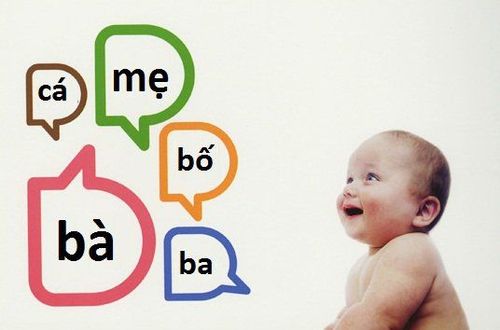This is an automatically translated article.
This article was written by Doctor Ma Van Tham - Internal Medicine Doctor, Vinmec Phu Quoc International General Hospital.At the age of holding, children live completely dependent on caregivers and nurturers, usually mother - father, or a surrogate. Therefore, psychology in this period is strongly influenced by the outside world.
1. Psychological characteristics of children at the holding age
Newborns sleep for most of the day. Babies of the cradle age can observe 6 states that are arranged in pairs of states as follows:
Quiet sleep and active sleep Quiet awake and active wake Loud and crying. Children respond differently to stimuli in these states. The basic sensory abilities of children this age may develop before the permanent expression of the senses later on.
Vision The baby's vision is not yet fully developed. Vision improves gradually over time. When the child is 4 months old, using the habitual training method, the ability to see colors is similar to that of an adult. A baby's vision develops at the same rate as an adult's when a child is 6 months old.
Hearing A baby's hearing ability is developed before the baby is born. Therefore, newborn babies have a tendency to prefer listening to mixed sounds to pure sounds, to listening to human voices over other sounds, to listening to mother's voice over human voices. and prefer listening to their mother tongue over another. These abilities are learned while still in the mother's womb. Babies of the cradle age are very good at first discovering when sounds are present.
Smell and taste At the age of holding babies, these senses are expressed through different expressions of satisfaction or anger when the baby receives pleasant aromas (such as milk or honey... ) or unpleasant (such as the smell of rotten eggs, substances with a sour taste, etc.). Children, whether breastfed or bottle-fed, after only 3 days of age, showed a preference for breast milk over other types of artificial milk. The evidence is also very clear that the older babies are, the more they prefer their mother's milk to other people's milk.
Language Babies are almost born with the ability to distinguish the sounds of human language. Language appears after the second month, initially as throaty sounds when someone looks at the baby talking. Babies at 6 months start babbling, making syllables. Months 10 - 12 can say simple words to indicate what children want such as eating, drinking, walking, playing...

Touch Touch is a well-developed sense at the time of birth. Under 05 months, the feeling has characteristics of indistinguishable nature. Babies can't distinguish between their mother's breast and their lips (just keep it close to their mouth, then suck) when they grasp something in their hands, they will grasp it tightly, unable to distinguish themselves and objects. It is called the phase of merging mother and object. From the sixth month onwards, the baby is able to reach out to grasp objects, touch them. At that time, the baby already has a combination of eyes seeing, hearing, hands touching, mouth tasting, nose smelling. This helps the baby gradually acquire the properties of the objects. This is the first manifestation of intellectual development. Around 8-9 months onwards, babies gradually learn to combine successive mixed sensations. Children begin to recognize separate objects. Children also understand cause-effect relationships, time-space in a simple way.
From the age of 8 months, babies have the ability to search to find hidden objects and will patiently detect when objects move. The older the baby, the better the perception of the object after the first observation. The experiment was conducted with the presence of toys that were repeatedly observed by the child. Before the age of 8 months, children do not have the ability to understand about fixed objects, including people. This explains why the baby doesn't cry when the mother leaves. From the 7th to 8th month, the baby knows how to distinguish strangers from those to whom he is attached. Expressions of fear appear when being away from mother, close person, fear of strangers, fear of strange places...
Pain Children who are held in their arms have similar pain reactions in later ages.
The child's perception and understanding of the world around him at this age depends on the child's motor development. The motor development is gradually enhanced with age such as lifting the head, rolling, crawling, standing and walking, thus gradually enhancing the child's sensory development and perception of the surrounding phenomena. The development of children at this age such as senses, language systems and social relations depends a lot on stimuli from the environment. This stage is said to be the pivotal stage. If the child does not have the right stimulation, he or she will fail in the important skills needed at this stage that cannot be learned at later stages. This period is the period of "creating fundamental trust" as opposed to "distrusting". Children who are well cared for and nurtured, ensuring their safety, will develop good psychology and adapt easily. If nurtured poorly, creating early disappointment, later will be less adaptive, lack the ability to communicate and behave.
In the role of foster care, MOTHER - is the person who plays the main and very important role. The initial communication between mother and child, through the interaction between the mother and child's body such as holding, hugging, bathing or nursing, caressing... forms a mother-child bond.
The mother-child relationship creates a mother's sophistication in sensing and appropriately responding to the child's needs, protecting and ensuring the child's safety, helping the child develop a balance of all aspects.
With babies, the initial perception and communication between mother and baby by touch, taste, smell, and sight are very sensitive, helping to strengthen the mother-child relationship. The baby looks at the mother's face, smells the mother's breath, sucks the nipple and tastes the mother's milk, hears the mother's caress, lulls...feels the softness of the mother's skin, waits for the mother's response to every love your request.
A good mother must have at least 2 virtues: being ready to meet her child's needs at any time and being sensitive, responding correctly and promptly to the signals her child gives off.
If during this period, some postpartum mothers suffer from depression due to stress or hormonal and physiological changes such as unwanted childbirth, abandonment by their husbands, conflicts with in-laws, fussy babies or illness. ... often have difficulty in forming a close relationship between mother and child. Consequences of a disorder in the mother-child attachment relationship are varied: anorexia, anorexia, lack of activity, inactivity, sadness, crying or struggling, little sleep... can manifest. physical symptoms such as vomiting, abdominal pain, no weight gain...
2. Eating disorders in breastfed babies and young children

About 35% of breastfed babies and young children have eating disorders. These are common eating difficulties such as eating too little or too much, limited eating preferences, unacceptable eating behaviors and peculiar eating habits... Some disorders Severe eating disorders such as refusal to eat, vomiting may be related to poor weight gain in children, accounting for 1-2% of children under 1 year of age.
Diagnosis: Eating disorder manifests in children frequently not eating enough and not gaining weight or losing weight, lasting at least one month. These disorders are not caused by diseases of the gastrointestinal tract or underlying medical conditions (Example: Gastroesophageal reflux disease) These disorders are not more suitable for disorders. other mental health or lack of food. Onset of the disease before the age of 6 years. Types of eating disorders:
2.1. Eating disorders due to instability Often appear in the first few months after birth, characterized by difficulty in creating stability and ease in eating, children do not eat enough, leading to inappropriate weight gain by age. The child exhibits instability in eating such as irritability, irritability, and/or excessive sleepiness. Mothers often present with anxiety, depression, psychopathy and/or stressors. These problems affect a mother's sensitivity to her baby and her ability to provide comfort and efficiency when feeding her baby.
2.2. Eating disorder due to attachment disorder usually begins to appear between the ages of 2 and 8 months, and is characterized by a lack of attachment between mother and child and marked physical underdevelopment. Mothers are often denied about their children's eating disorders and children are often referred to doctors for physical reasons and/or severe physical underdevelopment. Children exhibit a lack of age-appropriate social responses such as less eye contact, less conversation, less fondness for caresses, and less reluctance to lie still in their mother's arms. Children's mental and motor development may be delayed for their age. The mother may experience acute or chronic depression, personality disorders, alcohol or drug abuse, and/or severe trauma. The mother's medical conditions can lead to the mother's lack of emotion when caring for the baby and irregular feeding.
2.3. Separation eating disorder (anorexia in breastfed infants) Anorexia in breastfed infants is common between the ages of 9 and 18 months, during the transition to self-feeding. This disorder is characterized by children refusing food, causing parents anxiety and conflict in the mother-child relationship. A child's refusal to eat can vary with different meals and feeders. Usually, children show the most severe symptoms when the mother feeds them. Refusal to eat can lead to poor weight gain in children. In the opinion of parents, children have poor appetite, but are quick and demanding of everyone's attention, difficult and stubborn in meals. Children refuse parents' attempts to encourage them to eat. Parents often panic because children who do not eat may starve to death. Parents are concerned and frustrated about their child's poor eating habits, so often coax the child to eat more, distract the child's attention from toys, games or television, and spend a lot of time arranging meals. child's feeding and/or force-feeding if parents fail with these strategies.
Please dial HOTLINE for more information or register for an appointment HERE. Download MyVinmec app to make appointments faster and to manage your bookings easily.














